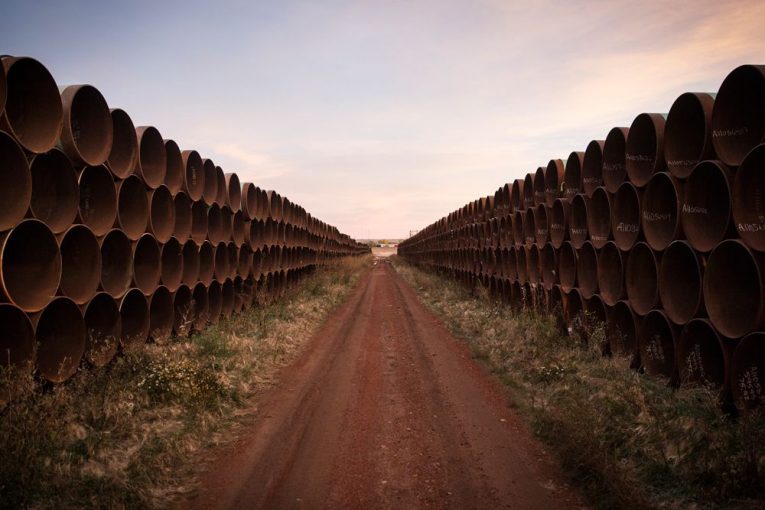
After weathering a hailstorm, it’s always welcome to see a little daylight on the horizon.
It’s been a turbulent week for Canada’s oil sector, but TC Energy said Thursday the base Keystone pipeline system will soon be able to
carry more oil from Alberta to key markets in the United States
.
U.S. President Donald Trump this week issued a permit that will allow the existing pipeline to increase its capacity.
TC Energy CEO Russ Girling expects it will begin moving an extra 50,000 barrels per day out of the country next year.
“The additional crude oil that will be delivered by the Keystone pipeline will increase the secure and reliable source of Canadian oil to meet growing demand from refineries and markets in the United States,” Girling said on a conference call Thursday.
The change won’t unclog Canada’s congested pipeline network, but it helps.
For an industry that’s endured feeble prices and a string of pipeline delays, followed by two negative pronouncements this week from
Deutsche Bank
and
France’s Total
, it’s a small respite.
“It is unequivocally good news,” said Dennis McConaghy, a former TransCanada executive and author of books about the country’s pipeline problems.
“This is not overwhelming, but in a world with all of the things that Alberta has gone through with constrained pipeline capacity . . . it is still significant.”
The new U.S. permit will let TC Energy increase shipments and the company says it can do so without making a major investment, as it optimizes the base system using drag-reducing agents.
The system capacity is being bumped up to 760,000 barrels per day, from the previous 590,000 bpd limitation.
To move up to the maximum level, however, TC Energy would need to hold an open season and sign up customers for additional volumes, which would take more time to complete, said company spokesman Terry Cunha.
For Alberta, the real prize is seeing the long-awaited Keystone XL project move ahead, capable of shipping 830,000 barrels of oil per day from Hardisty to Nebraska. It would then connect with the existing Keystone system, transporting western Canadian crude to U.S. Gulf Coast refiners.
The
Kenney government
made a $1.5-billion equity investment in the project and will also provide a $6-billion loan guarantee to see it built. However, recent court rulings involving national environmental permits needed to cross waterways have sidetracked some construction south of the border this summer.
Despite the recent court challenges, TC Energy still expects Keystone XL will come online in 2023.
Of course, that assumes Joe Biden doesn’t win the U.S. presidential election this November and promptly cancel the permit for the cross-border project, as he has promised.
Although it might seem like a long-forgotten issue with the fallout from the COVID-19 pandemic, the Canadian oilpatch has faced a debilitating lack of pipeline capacity in recent years.
It’s led to steep price discounts, production quotas and reduced investment in Alberta.
A collapse in oil prices and falling demand caused by the pandemic this spring saw about one million barrels per day (bpd) of Canadian production shut in, requiring less space on existing pipelines.
However, that is only temporary as more oil production is coming back online.
Husky Energy reported Thursday it has now brought back about 50,000 of the 80,000 bpd that it shut in earlier this year.
The sector will still need more pipelines once demand bounces back, said Dinara Millington, vice-president of research at the Canadian Energy Research Institute.
“An additional 50,000 barrels per day would alleviate some short-term pain from producers once, in a post-COVID recovery, we are back to normal levels of production,” she said.
Pipelines out of Western Canada can export about 3.9 million barrels per day and the timing of any additional Keystone capacity becoming available will be particularly helpful next year as production ramps back up.
For the oilpatch, silver linings have been in short supply recently.
Aside from an epic drop in oil prices and mammoth financial losses reported in the second quarter, the industry was hit with news this week that Deutsche Bank will not finance new oilsands projects due to climate considerations.
Husky Energy CEO Rob Peabody expressed disappointment with the bank’s position, saying it ignores the efforts of Canadian producers to lower emissions and “ensure the oil from the oilsands is just as competitive from a carbon intensity point of view as any other.”
Meanwhile, Paris-based Total announced Wednesday it will write down its Canadian oilsands assets by US$7 billion as it expects lower oil prices to prevail over a longer run. Total will also not approve new projects to boost capacity at its oilsands assets at Fort Hills and Surmont.
University of Calgary School of Public Policy executive fellow Robert Skinner, who worked as Total’s vice-president of oilsands and set up the company’s Calgary office in the 1990s, noted it’s not the only major European producer that has signalled discomfort with the oilsands over environmental and pricing concerns.
Yet, the decision doesn’t consider the reductions in emissions per barrel that are now being seen, or the promise of improved technology to make further improvements, he added.
“It’s kind of sad that Total is saying we don’t think there’s any possibility that technology can address the oilsands’ problem,” Skinner said.
Canadian oilsands producers and pipeline operators are locked in a long-term battle. There will no shortage of scuffles ahead, at home or abroad.
But a little more pipeline access helps, even if it arrives in the middle of another stormy season.
Chris Varcoe is a Calgary Herald columnist.
You can read more of the news on source
